
EXAR Corporation, 48720 Kato Road, Fremont, CA 94538
∑
(510) 668-7000
∑
FAX (510) 668-7017
ST16C1450/51
PLCC Package
UNIVERSAL ASYNCHRONOUS RECEIVER/
TRANSMITTER ( UART)
DESCRIPTION
The ST16C1450, ST16C1451 series (here on denoted as the 145X) is a universal asynchronous receiver and
transmitter (UART). The 145X is foot print compatible to the SSI 73M1550 and SSI 73M2550 UART with one byte
FIFO and higher operating speed and lower access time. The 145X provides enhanced UART functions with a
modem control interface, independent programmable baud rate generators with clock rates to 1.5 Mbps. Onboard
status registers provide the user with error indications and operational status. System interrupts and modem
control features may be tailored by external software to meet specific user requirements. An internal loop-back
capability allows onboard diagnostics. The 145X is available in a 28-pin PLCC/plastic-DIP, 48-pin TQFP
packages. The Baud rate generator can be configured for either crystal or external clock input with the exception
of the 28 pin 1451 package. An external clock must be provided for the 28 pin 1451 package. Each package type,
with the exception of the 28 pin 1450, provides a buffered reset output that can be controlled through user software.
The 145X is fabricated in an advanced CMOS process to achieve low drain power and high speed requirements.
FEATURES
∑
Pin compatible to SSI 73M1550/2550/Software
compatible INS8250, NS16450
∑
1.5 Mbps transmit/receive operation (24MHz
Max.) with programmable clock control
∑
Modem control signals (-CTS, -RTS, -DSR, -DTR,
-RI, -CD).
∑
Programmable character lengths (5, 6, 7, 8) with
Even, odd, or no parity.
∑
Four levels of prioritized interrupts, minimize ex-
ternal software interaction
∑
Software controlled tri-state interrupt outputs
∑
Provides enhanced 16C450 features for power
down and software controllable reset output
∑
Crystal or external clock input (except 28 pin
ST16C1451)
∑
460.8 Kbps transmit/receive operation with 7.3728
MHz crystal or external clock source
ORDERING INFORMATION
Part number
Pin Package
Operating temperature
ST16C1450CP28 28 PDIP
0∞ C to + 70∞ C
ST16C1450CJ28 28 PLCC
0∞ C to + 70∞ C
ST16C1450CQ48 48 TQFP
0∞ C to + 70∞ C
ST16C1451CP28 28 PDip
0∞ C to + 70∞ C
ST16C1451CJ28 28 PLCC
0∞ C to + 70∞ C
ST16C1451CQ48 48 TQFP
0∞ C to + 70∞ C
Part number
Pin Package
Operating temperature
ST16C1450IP28
28 PDIP
-40∞ C to + 85∞ C
ST16C1450IJ28
28 PLCC
-40∞ C to + 85∞ C
ST16C1450IQ48 48 TQFP
-40∞ C to + 85∞ C
ST16C1451IP28
28 PDip
-40∞ C to + 85∞ C
ST16C1451IJ28
28 PLCC
-40∞ C to + 85∞ C
ST16C1451IQ48 48 TQFP
-40∞ C to + 85∞ C
4
3
2
1
28
27
26
5
6
7
8
9
10
11
25
24
23
22
21
20
19
12
13
14
15
16
17
18
D4
D5
D6
D7
RX
TX
-CS
-CTS
RESET
-DTR
-RTS
A0
A1
A2
D3
D2
D1
D0
VC
C
-CD
-DS
R
XT
AL
1
XT
AL
2
-IOW
GN
D
-IOR
-RI
IN
T
ST16C1450CJ28
Rev. 3.10

ST16C1450/51
2
Rev. 3.10
48 Pin TQFP Package
28 Pin Package DIP
Figure 1, Package Descriptions, 28 pin, 48 pin ST16C1450/51
28 Pin PLCC Package
1
2
3
4
5
6
7
8
9
10
11
12
13
14
28
27
26
25
24
23
22
21
20
19
18
17
16
15
D0
D1
D2
D3
D4
D5
D6
D7
RX
TX
-CS
XTAL1
XTAL2
-IOW
VCC
-CD
-DSR
-CTS
RESET
-DTR
-RTS
A0
A1
A2
INT
-RI
-IOR
GND
S
T
16
C145
0C
P
2
8
4
3
2
1
28
27
26
5
6
7
8
9
10
11
25
24
23
22
21
20
19
12
13
14
15
16
17
18
D4
D5
D6
D7
RX
TX
-CS
-CTS
-RESET
-DTR
-RTS
A0
A1
A2
D3
D2
D1
D0
VC
C
-CD
-DS
R
CL
K
-I
O
W
GND
-I
O
R
-RI
RS
T
IN
T
ST16C1451CJ28
48
47
46
45
44
43
42
41
40
39
38
37
1
2
3
4
5
6
7
8
9
10
11
12
36
35
34
33
32
31
30
29
28
27
26
25
13
14
15
16
17
18
19
20
21
22
23
24
N.C.
N.C.
D4
D5
D6
D7
RX
TX
-CS
N.C.
N.C.
N.C.
N.C.
N.C.
-CTS
RESET
-DTR
-RTS
A0
N.C.
A1
A2
N.C.
N.C.
N.
C.
D3
D2
D1
N.
C.
D0
N.
C.
VC
C
-C
D
-D
S
R
N.
C.
N.
C.
N.
C.
N.
C.
XT
A
L
1
XT
A
L
2
-I
O
W
N.
C.
GN
D
-I
O
R
-R
I
RS
T
INT
N.
C.
ST16C145XCQ48
1
2
3
4
5
6
7
8
9
10
11
12
13
14
28
27
26
25
24
23
22
21
20
19
18
17
16
15
D0
D1
D2
D3
D4
D5
D6
D7
RX
TX
-CS
CLK
-IOW
GND
VCC
-CD
-DSR
-CTS
RESET
-DTR
-RTS
A0
A1
A2
INT
RST
-RI
-IOR
S
T
16
C145
1C
P
2
8

ST16C1450/51
3
Rev. 3.10
Figure 2, Block Diagram
D0-D7
-IOR
-IOW
RESET
RST
A0-A2
-CS
INT
-DTR,-RTS
-CTS
-RI
-CD
-DSR
TX
RX
Dat
a
bu
s
&
Co
n
t
r
o
l
L
o
g
i
c
Reg
i
s
t
e
r
Sele
ct
Lo
g
i
c
Modem
Control
Logic
In
t
e
rr
u
p
t
Co
n
t
r
o
l
Lo
g
i
c
Transmit
Holding
Registers
Transmit
Shift
Register
Receive
Holding
Registers
Receive
Shift
Register
In
t
e
r Co
n
n
e
c
t
Bu
s
Li
n
e
s
&
C
o
nt
rol s
i
gn
als
Clock
&
Baud Rate
Generator
X
TA
L
1
CL
K
X
TA
L
2

ST16C1450/51
4
Rev. 3.10
SYMBOL DESCRIPTION
Symbol
Pin
Signal
Pin Description
28
28
48
type
A0
21
21
30
I
Address-0 Select Bit. - Internal register address selection.
A1
20
20
28
I
Address-1 Select Bit. - Internal register address selection.
A2
19
19
27
I
Address-2 Select Bit. - Internal register address selection.
CLK
-
12
-
I
Clock Input. - This function is associated with 28 pin
ST16C1451CJ28 package only. An external clock must be
connected to this pin to clock the baud rate generator and
internal circuitry (see Programmable Baud Rate Genera-
tor).
-CS
11
11
9
I
Chip Select (active low) - A logic 0 on this pin selects the
UART I/O for external access. Data can be transferred
between the user CPU and the 145X or the 145X and the
CPU.
D0-D7
1-8
1-8
43,
45-47,
3-6
I/O
Data Bus (Bi-directional) - These pins are the eight bit, tri-
state data bus for transferring information to or from the
controlling CPU. D0 is the least significant bit and the first
data bit in a transmit or receive serial data stream.
GND
15
14
19
Pwr
Signal and power ground.
INT
18
18
23
O
Interrupt (three state, active high) - This function is associ-
ated with UART channel interrupts (INT). INT is enabled
when MCR bit-3 is set to a logic 1, interrupts are enabled in
the interrupt enable register (IER), and when an interrupt
condition exists. Interrupt conditions include: receiver er-
rors, available receiver buffer data, transmit buffer empty,
or when a modem status flag is detected.
-IOR
16
15
20
I
Read strobe. (active low strobe) - A logic 0 transition on this
pin will load the contents of an Internal register defined by
address bits A0-A2 onto the 145X data bus (D0-D7) for
access by an external CPU.
-IOW
14
13
17
I
Write strobe. (active low strobe) - A logic 0 transition on this

ST16C1450/51
5
Rev. 3.10
SYMBOL DESCRIPTION
Symbol
Pin
Signal
Pin Description
28
28
48
type
pin will transfer the contents of the data bus (D0-D7) from
the external CPU to an internal register that is defined by
address bits A0-A2.
RESET
24
24
33
I
Reset. (active high) - A logic 1 on this pin will reset the
internal registers and all the outputs (Also see signal RST).
The UART transmitter output and the receiver input will be
disabled during reset time. (See 145X External Reset
Conditions for initialization details.)
RST
-
17
22
O
Reset output (active high). This function is associated with
the 28 pin ST16C1451 and the 48 pin ST16C1450/51
packages only. This function provides a buffered RESET
output that operates in two modes. The modes are config-
ured by IER bit-5. When IER bit-5 is a logic 0, the standard
reset mode is selected and RST will follow the logical state
of the RESET pin (see RESET). When IER bit-5 is a logic
1, the special mode is selected. During special mode
operation, the user may send software (SOFT) resets via
MCR bit-2. This is useful when the user desires the capabil-
ity of resetting an externally connected device only. During
special mode operation, soft resets from MCR bit 2 are
ORd with the state of the input pin, RESET. Therefore
both reset types will be seen at the RST pin.
VCC
28
28
41
Pwr
Power supply input.
XTAL1
12
-
15
I
Crystal or External Clock Input - This function is associated
with all packages types except the 28 pin ST16C1451,
which must have external clock (see CLK). Functions as a
crystal input or as an external clock input. A crystal can be
connected between this pin and XTAL2 to form an internal
oscillator circuit. This configuration requires an external 1
M
resistor between the XTAL1 and XTAL2 pins. Alterna-
tively, an external clock can be connected to this pin to
provide custom data rates (see Baud Rate Generator
Programming).
XTAL2
13
-
16
O
Output of the Crystal Oscillator or Buffered Clock - (See also
XTAL1). - This function is associated with all packages
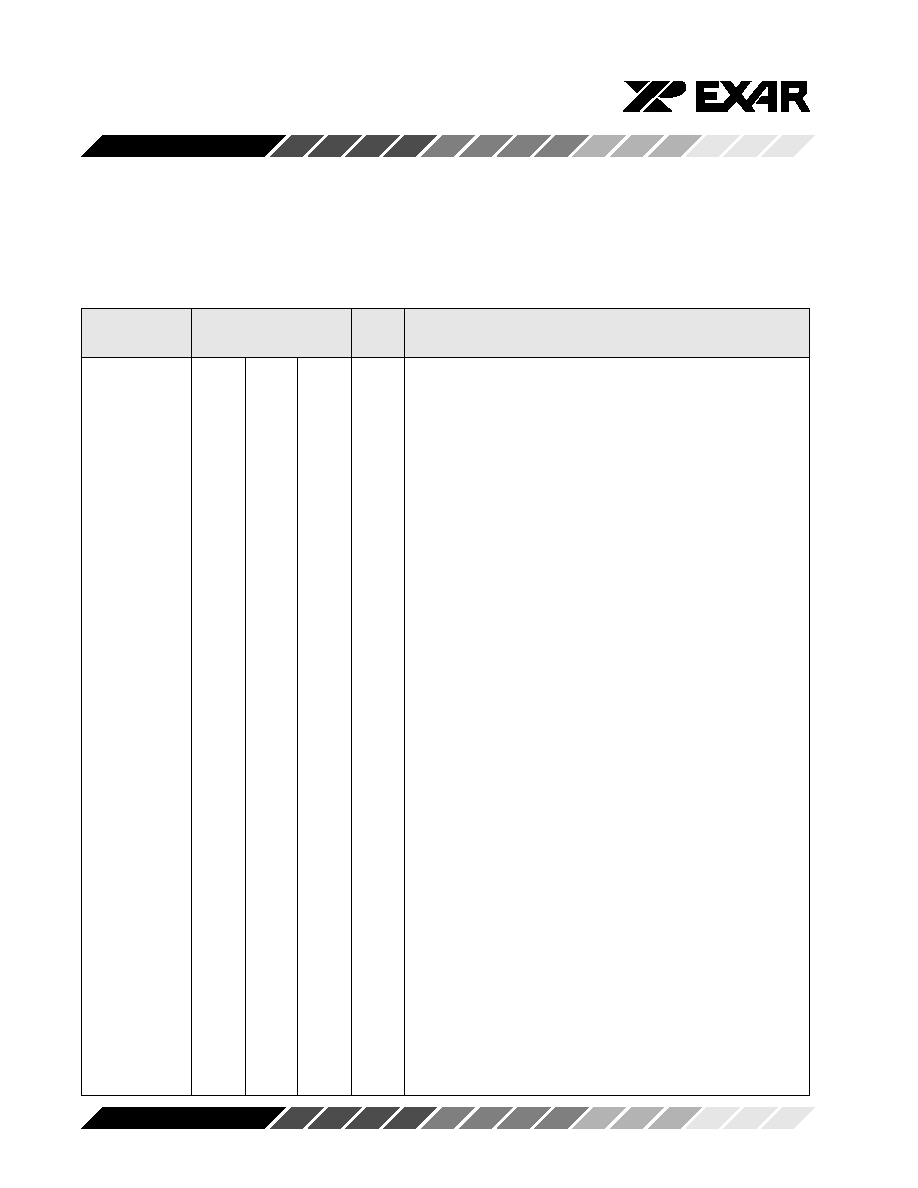
ST16C1450/51
6
Rev. 3.10
types except the 28 pin ST16C1451. The crystal oscillator
output or buffered clock output should be left open if an
external clock is connected to XTAL1.
-CD
27
27
40
I
Carrier Detect (active low) - A logic 0 on this pin indicates
that a carrier has been detected by the modem.
-CTS
25
25
34
I
Clear to Send (active low) - A logic 0 on the -CTS pin
indicates the modem or data set is ready to accept transmit
data from the 145X. Status can be tested by reading MSR
bit-4. This pin has no effect on the UARTs transmit or
receive operation.
-DSR
26
26
39
I
Data Set Ready (active low) - A logic 0 on this pin indicates
the modem or data set is powered-on and is ready for data
exchange with the UART. This pin has no effect on the
UARTs transmit or receive operation.
-DTR
23
23
32
O
Data Terminal Ready (active low) - A logic 0 on this pin
indicates that the 145X is powered-on and ready. This pin
can be controlled via the modem control register. Writing a
logic 1 to MCR bit-0 will set the -DTR output to logic 0,
enabling the modem. This pin will be a logic 1 after writing
a logic 0 to MCR bit-0, or after a reset. This pin has no effect
on the UARTs transmit or receive operation.
-RI
17
16
21
I
Ring Indicator (active low) - A logic 0 on this pin indicates the
modem has received a ringing signal from the telephone
line. A logic 1 transition on this input pin will generate an
interrupt.
-RTS
22
22
31
O
Request to Send (active low) - A logic 0 on the -RTS pin
indicates the transmitter has data ready and waiting to send.
Writing a logic 1 in the modem control register (MCR bit-1)
will set this pin to a logic 0 indicating data is available. After
a reset this pin will be set to a logic 1. This pin has no effect
on the UARTs transmit or receive operation.
RX
9
9
7
I
Receive Data - This input is associated with individual serial
channel data to the 145X receive input circuit. The RX signal
SYMBOL DESCRIPTION
Symbol
Pin
Signal
Pin Description
28
28
48
type

ST16C1450/51
7
Rev. 3.10
Symbol
Pin
Signal
Pin Description
28
28
48
type
will be a logic 1 during reset, idle (no data), or when the
transmitter is disabled. During the local loop-back mode,
the RX input pin is disabled and TX data is connected to the
UART RX Input, internally.
TX
10
10
8
O
Transmit Data (A-B) - This output is associated with indi-
vidual serial transmit channel data from the 145X. The TX
signal will be a logic 1 during reset, idle (no data), or when
the transmitter is disabled. During the local loop-back
mode, the TX output pin is disabled and TX data is internally
connected to the UART RX Input.
All unused input pins should be tied to VCC or GND.
SYMBOL DESCRIPTION

ST16C1450/51
8
Rev. 3.10
GENERAL DESCRIPTION
The 145X provides serial asynchronous receive data
synchronization, parallel-to-serial and serial-to-paral-
lel data conversions for both the transmitter and
receiver sections. These functions are necessary for
converting the serial data stream into parallel data that
is required with digital data systems. Synchronization
for the serial data stream is accomplished by adding
start and stops bits to the transmit data to form a data
character (character orientated protocol). Data integ-
rity is insured by attaching a parity bit to the data
character. The parity bit is checked by the receiver for
any transmission bit errors. The electronic circuitry to
provide all these functions is fairly complex especially
when manufactured on a single integrated silicon
chip. The 145X represents such an integration with
greatly enhanced features. The 145X is fabricated
with an advanced CMOS process.
The 145X is an upward solution that is designed to
work with high speed modems and shared network
environments, that require fast data processing time.
Increased performance is realized in the 145X by
providing higher operating speed and lower access
time. This allows the external processor to handle
more networking tasks within a given time. The im-
proved performance reduces the bandwidth require-
ment for the external controlling CPU, increasing
performance, and reducing power consumption.
The 145X is capable of operation to 1.5Mbps with a 24
MHz clock input. With a crystal or external clock input
of 7.3728 MHz the user can select data rates up to
460.8 Kbps. Internal crystal clock operation is not
available on the 28 pin ST16C1451.
The rich feature set of the 145X is available through
internal registers. Selectable TX and RX baud rates,
and modem interface controls are all standard fea-
tures. Following a power on reset or an external reset,
the 145X is software compatible with the, ST16C450.
FUNCTIONAL DESCRIPTIONS
UART Functions
The UART provides the user with the capability to Bi-
directionally transfer information between an external
CPU, the 145X package, and an external serial de-
vice. A logic 0 on the chip select pin -CS allows the
user to configure, send data, and/or receive data via
the UART.
Internal Registers
The 145X provides 11 internal registers for monitoring
and control of the UART functions. These resisters are
shown in Table 3 below. The UART registers function
as data holding registers (THR/RHR), interrupt status
and control registers (IER/ISR), line status and control
registers (LCR/LSR), modem status and control reg-
isters (MCR/MSR), programmable data rate (clock)
control registers (DLL/DLM), and a user assessable
scratchpad register (SPR).
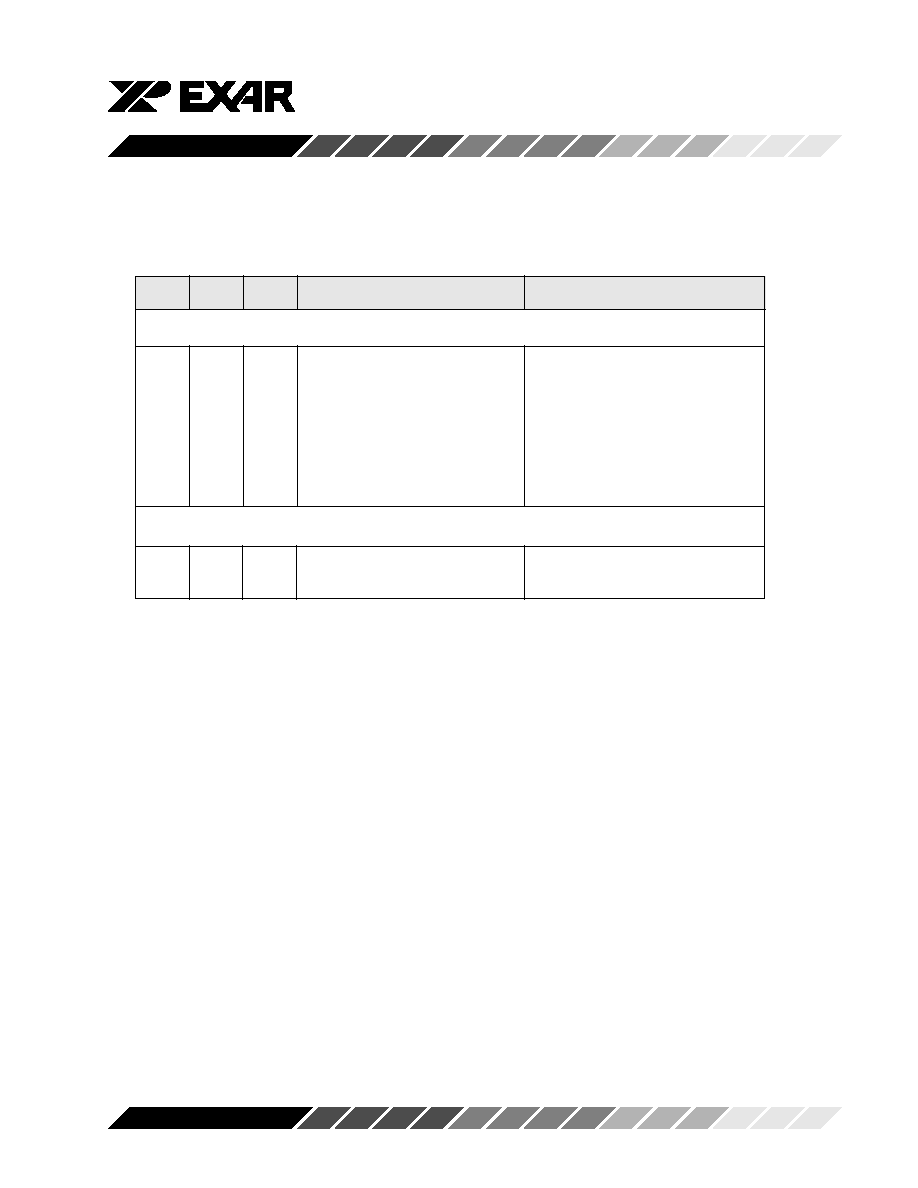
ST16C1450/51
9
Rev. 3.10
Table 3, INTERNAL REGISTER DECODE
A2
A1
A0
READ MODE
WRITE MODE
General Register Set (THR/RHR, IER/ISR, MCR/MSR, LCR/LSR, SPR): Note 1*
0
0
0
Receive Holding Register
Transmit Holding Register
0
0
1
Interrupt Enable Register
0
1
0
Interrupt Status Register
0
1
1
Line Control Register
1
0
0
Modem Control Register
1
0
1
Line Status Register
1
1
0
Modem Status Register
1
1
1
Scratchpad Register
Scratchpad Register
Baud Rate Register Set (DLL/DLM): Note *2
0
0
0
LSB of Divisor Latch
LSB of Divisor Latch
0
0
1
MSB of Divisor Latch
MSB of Divisor Latch
Note 1* The General Register set is accessible only when CS is a logic 0.
Note 2* The Baud Rate register set is accessible only when CS is a logic 0 and LCR bit-7 is a logic 1.
Programmable Baud Rate Generator
The 145X supports high speed modem technologies
that have increased input data rates by employing
data compression schemes. For example a 33.6Kbps
modem that employs data compression may require a
115.2Kbps input data rate. A 128.0Kbps ISDN modem
that supports data compression may need an input
data rate of 460.8Kbps.
A single baud rate generator is provided for both the
transmitter and receiver. The programmable Baud
Rate Generator is capable of accepting an input clock
up to 24 MHz, as required for supporting a 1.5Mbps
data rate. The 145X can be configured for internal
clock (XTAL) operation on all packages except the 28
pin ST16C1451. The 28 pin ST16C1451 requires an
external clock input and this device can not be config-
ured for internal (XTAL) operation. For internal (XTAL)
clock oscillator operation, an industry standard micro-
processor crystal (parallel resonant/ 22-33 pF load) is
connected externally between the XTAL1 and XTAL2
pins, with an external 1 M
resistor across it. Alterna-
tively, an external clock can be connected to the
XTAL1 pin to clock the internal baud rate generator for
standard or custom rates. (see Baud Rate Generator
Programming).
The generator divides the input 16X clock by any
divisor from 1 to 2
16
-1. The 145X divides the basic
external clock by 16. The basic 16X clock provides
data rates to support standard and custom applica-
tions using the same system design. The data rate is
configured via the DLL and DLM internal register
functions. Customized Baud Rates can be achieved
by selecting the proper divisor values for the MSB and
LSB sections of baud rate generator.
Programming the Baud Rate Generator Registers
DLM (MSB) and DLL (LSB) provides a user capability
for selecting the desired final baud rate. The example
in Table 4 below, shows the selectable baud rates
available when using a 1.8432 MHz external clock
input.
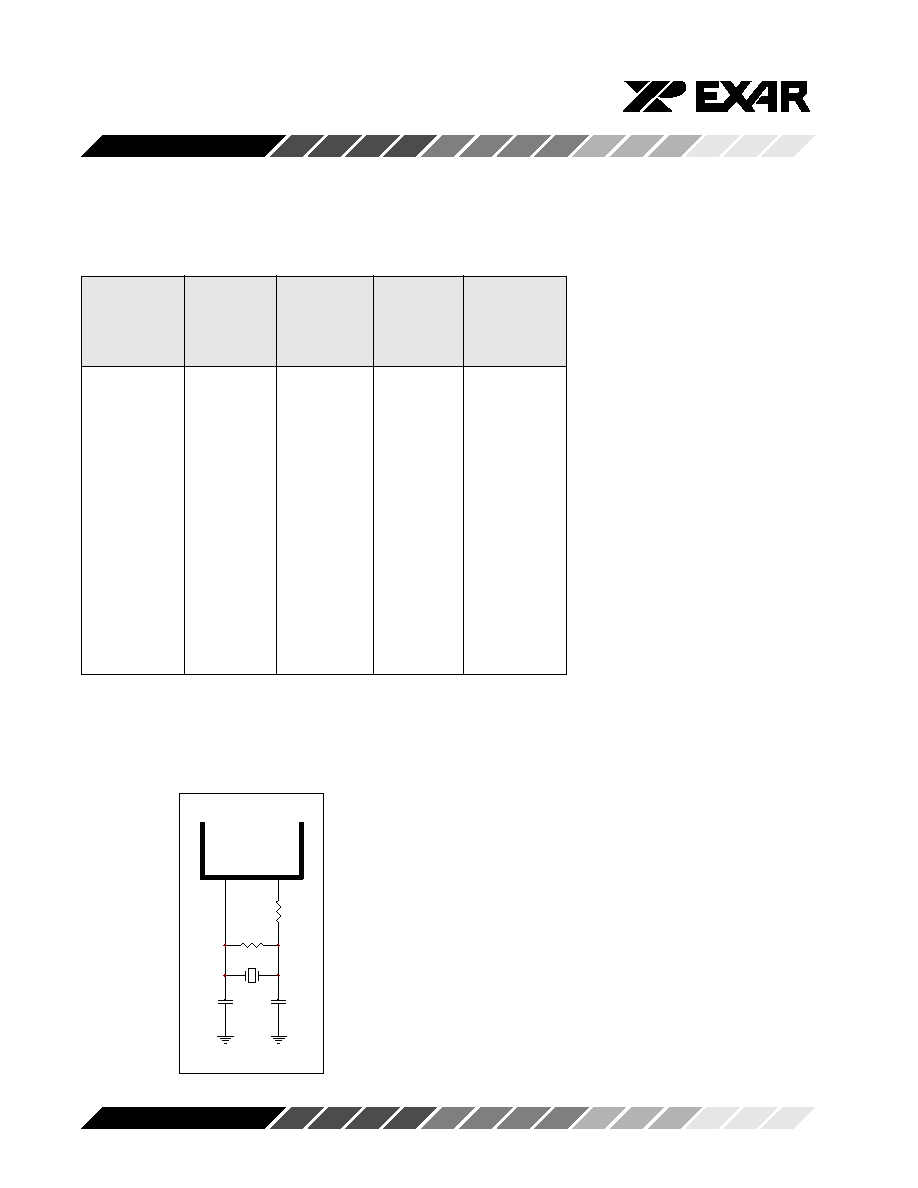
ST16C1450/51
10
Rev. 3.10
Table 4, BAUD RATE GENERATOR PROGRAMMING TABLE (1.8432 MHz CLOCK):
Output
Output
User
DLM
DLL
Baud Rate
16 x Clock
16 x Clock
Program
Program
Divisor
Divisor
Value
Value
(Decimal)
(HEX)
(HEX)
(HEX)
50
2304
900
09
00
75
1536
600
06
00
110
1047
417
04
17
150
768
300
03
00
300
384
180
01
80
600
192
C0
00
C0
1200
96
60
00
60
2400
48
30
00
30
3600
32
20
00
20
4800
24
18
00
18
7200
16
10
00
10
9600
12
0C
00
0C
19.2k
6
06
00
06
38.4k
3
03
00
03
57.6k
2
02
00
02
115.2k
1
01
00
01
Crystal oscillator connection
C1
22pF
C2
33pF
X1
1.8432 MHz
R1
50-120
R2
1M
XTA
L
1
XTA
L
2

ST16C1450/51
11
Rev. 3.10
Special (Enhanced Feature) Mode
The 145X supports the standard features of the
ST16C450. In addition the 145X supports two en-
hanced features not available on the ST16C450 pack-
age. These features are enabled by bit-5 of the IER
register and include a software controllable (SOFT)
reset and a power down feature. The power down
feature (controlled by MCR bit-7) provides the user
with the capability to conserve power when the pack-
age is not in actual use with out destroying internal
register configuration data. This allows quick turn-
around from power down to returned package opera-
tion. Each package type, with the exception of the 28
pin 1450, provides a buffered reset output that can be
controlled through user software. When enabled by
the IER register, MCR bit-7 can be used to power down
the 145X and/or MCR bit-2 can be used to initiate a
SOFT reset at the RST output pin. Soft resets are
useful when the user desires the capability of resetting
an externally connected device only. During special
mode operation, soft resets from MCR bit 2 are ORd
with resets on the input pin, RESET. Therefore both
reset types will be seen at the RST pin.
Loop-back Mode
The internal loop-back capability allows onboard diag-
nostics. In the loop-back mode the normal modem
interface pins are disconnected and reconfigured for
loop-back internally. MCR register bits 0-3 are used
for controlling loop-back diagnostic testing. In the
loop-back mode INT enable and MCR bit-2 in the MCR
register (bits 3/2) control the modem -RI and -CD
inputs respectively. MCR signals -DTR and -RTS (bits
0-1) are used to control the modem -CTS and -DSR
inputs respectively. The transmitter output (TX) and
the receiver input (RX) are disconnected from their
associated interface pins, and instead are connected
together internally (See Figure 4). The -CTS, -DSR, -
CD, and -RI are disconnected from their normal
modem control inputs pins, and instead are connected
internally to -DTR, -RTS, INT enable and MCR bit-2.
Loop-back test data is entered into the transmit hold-
ing register via the user data bus interface, D0-D7.
The transmit UART serializes the data and passes the
serial data to the receive UART via the internal loop-
back connection. The receive UART converts the
serial data back into parallel data that is then made
available at the user data interface, D0-D7. The user
optionally compares the received data to the initial
transmitted data for verifying error free operation of
the UART TX/RX circuits.
In this mode, the receiver and transmitter interrupts
are fully operational. The Modem Control Interrupts
are also operational. However, the interrupts can only
be read using lower four bits of the Modem Control
Register (MCR bits 0-3) instead of the four Modem
Status Register bits 4-7. The interrupts are still con-
trolled by the IER.

ST16C1450/51
12
Rev. 3.10
Figure 4, INTERNAL LOOP-BACK MODE DIAGRAM
D0-D7
-IOR,-IOW
RESET
RST
A0-A2
-CS
INT
TX
RX
Da
ta bu
s
&
Co
n
t
r
o
l
L
o
g
i
c
Re
g
i
s
t
e
r
S
e
l
ect
Log
i
c
M
o
de
m
C
o
n
t
r
o
l
L
o
gic
In
t
e
rr
u
p
t
Co
n
t
r
o
l
Log
i
c
Transmit
Holding
Registers
Transmit
Shift
Register
Receive
Holding
Registers
Receive
Shift
Register
In
t
e
r C
o
n
n
e
c
t
B
u
s L
i
n
e
s
&
C
o
n
t
r
o
l
s
i
gn
al
s
Clock
&
Baud Rate
Generator
X
TA
L
1
CL
K
X
TA
L
2
-CTS
-RTS
-DTR
-DSR
-RI
-CD
(-OP1)
(-OP2)
MC
R Bi
t-
4
=
1
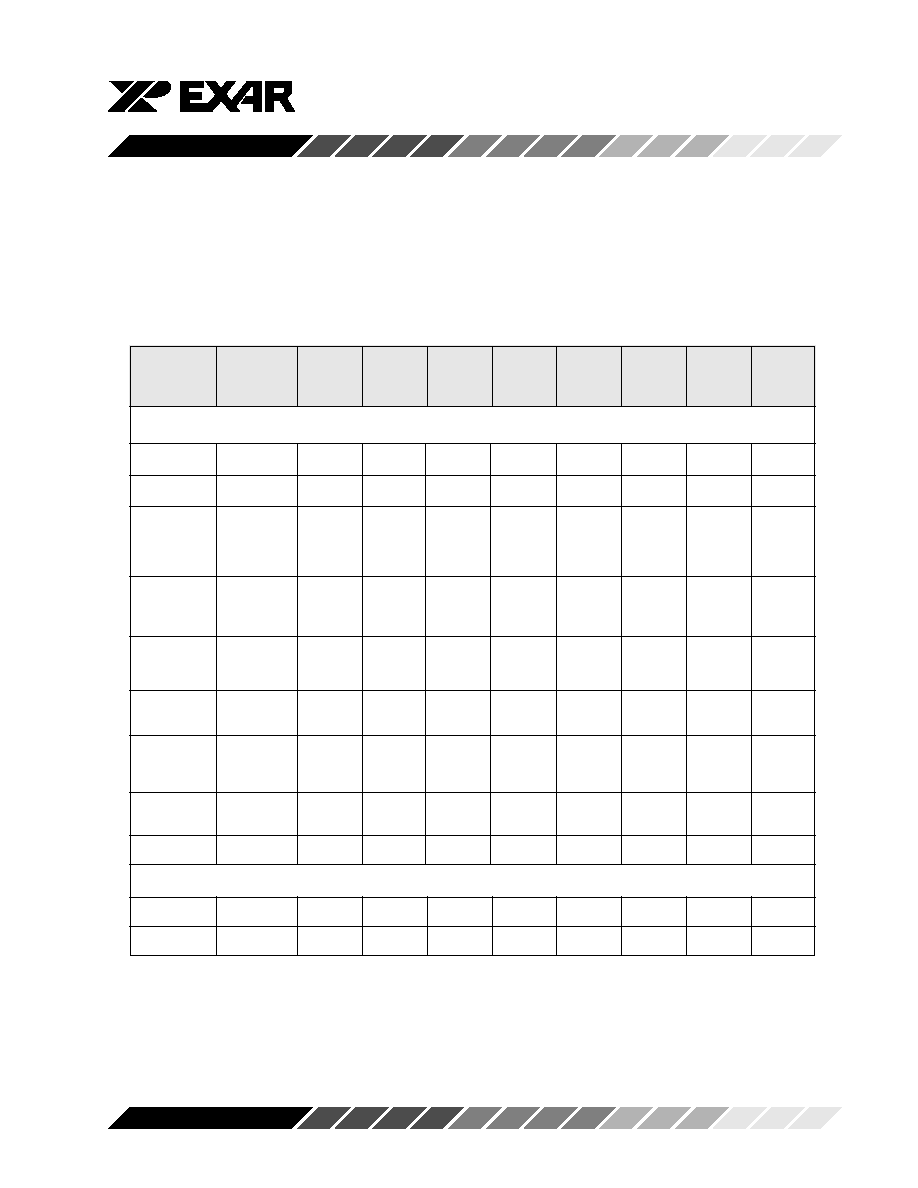
ST16C1450/51
13
Rev. 3.10
REGISTER FUNCTIONAL DESCRIPTIONS
The following table delineates the assigned bit functions for the twelve 145X internal registers. The assigned bit
functions are more fully defined in the following paragraphs.
Table 5, ST16C145X INTERNAL REGISTERS
A2 A1 A0
Register
BIT-7
BIT-6
BIT-5
BIT-4
BIT-3
BIT-2
BIT-1
BIT-0
[Default]
Note 3*
General Register Set: Note 1*
0 0 0
RHR [XX]
bit-7
bit-6
bit-5
bit-4
bit-3
bit-2
bit-1
bit-0
0 0 0
THR [XX]
bit-7
bit-6
bit-5
bit-4
bit-3
bit-2
bit-1
bit-0
0 0 1
IER [00]
0
0
Special
0
Modem
Receive
Transmit
Receive
Mode
Status
Line
Holding
Holding
Enable
Interrupt
Status
Register
Register
interrupt
interrupt
interrupt
0 1 0
ISR [01]
0
0
0
0
INT
INT
INT
INT
priority
priority
priority
status
bit-2
bit-1
bit-0
0 1 1
LCR [00]
divisor
set
set
even
parity
stop
word
word
latch
break
parity
parity
enable
bits
length
length
enable
bit-1
bit-0
1 0 0
MCR [00]
Power
0
0
loop
INT
SOFT
-RTS
-DTR
Down
back
enable
Reset
1 0 1
LSR [60]
0
THR &
THR.
break
framing
parity
overrun
receive
TSR
empty
interrupt
error
error
error
data
empty
ready
1 1 0
MSR [X0]
CD
RI
DSR
CTS
delta
delta
delta
delta
-CD
-RI
-DSR
-CTS
1 1 1
SPR [FF]
bit-7
bit-6
bit-5
bit-4
bit-3
bit-2
bit-1
bit-0
Special Register Set: Note *2
0 0 0
DLL [XX]
bit-7
bit-6
bit-5
bit-4
bit-3
bit-2
bit-1
bit-0
0 0 1
DLM [XX]
bit-15
bit-14
bit-13
bit-12
bit-11
bit-10
bit-9
bit-8
Note 1* The General Register set is accessible only when CS is a logic 0.
Note 2* The Baud Rate register set is accessible only when CS is a logic 0 and LCR bit-7 is a logic 1.
Note 3*
The value between the square brackets represents the registers initialized HEX value, X = N/A.

ST16C1450/51
14
Rev. 3.10
Transmit (THR) and Receive (RHR) Holding Reg-
isters
The serial transmitter section consists of an 8-bit
Transmit Hold Register (THR) and Transmit Shift
Register (TSR). The status of the THR is provided in
the Line Status Register (LSR). Writing to the THR
transfers the contents of the data bus (D7-D0) to the
TSR and UART via the THR, providing that the THR
is empty. The THR empty flag in the LSR register will
be set to a logic 1 when the transmitter is empty or
when data is transferred to the TSR. Note that a write
operation can be performed when the transmit holding
register empty flag is set.
The serial receive section also contains an 8-bit
Receive Holding Register, RHR and a Receive Serial
Shift Register (RSR). Receive data is removed from
the 145X by reading the RHR register. The receive
section provides a mechanism to prevent false starts.
On the falling edge of a start or false start bit, an
internal receiver counter starts counting clocks at the
16x clock rate. After 7 1/2 clocks the start bit time
should be shifted to the center of the start bit. At this
time the start bit is sampled and if it is still a logic 0 it
is validated. Evaluating the start bit in this manner
prevents the receiver from assembling a false charac-
ter. Receiver status codes will be posted in the LSR.
Interrupt Enable Register (IER)
The interrupt Enable Register (IER) masks the inter-
rupts from receiver ready, transmitter empty, line
status and modem status registers. These interrupts
would normally be activated at the INT output pin.
IER BIT-0:
This interrupt will be issued when the RHR has data or
is cleared when the RHR is empty.
Logic 0 = Disable the receiver ready interrupt. (normal
default condition)
Logic 1 = Enable the RXRDY interrupt.
IER BIT-1:
This interrupt will be issued whenever the THR is
empty and is associated with bit-5 in the LSR register.
This interrupt will be issued whenever the THR is
empty
Logic 0 = Disable the Transmit Holding Register
Empty (TXRDY) interrupt. (normal default condition)
Logic 1 = Enable the TXRDY interrupt.
IER BIT-2:
This interrupt will be issued whenever an receive data
error condition exists as reflected in LSR bits 1-4.
Logic 0 = Disable the receiver line status interrupt.
(normal default condition)
Logic 1 = Enable the receiver line status interrupt.
IER BIT-3:
This interrupt will be issued whenever there is a
modem status change as reflected in MSR bits 0-3.
Logic 0 = Disable the modem status register interrupt.
(normal default condition)
Logic 1 = Enable the modem status register interrupt.
IER BIT 4-:
Not Used - initialized to a logic 0.
IER BIT 5:
This bit is used to enable the enhanced features of the
145X. Enhanced features include SOFT reset func-
tion, and the power down function. When enabled
(IER bit-5 = a logic 1), a logic 1 at MCR bit will power
down the 145X, the logical state of MCR bit-2 will be
reflected at the RST output pin.
Logic 0 = enable basic ST16C450 functions only.
(normal default condition).
Logic 1 = enable special mode functions in addition to
basic ST16C450 functions, MCR bit-2 (soft reset) and
MCR bit-7 (power down) functions.
IER BIT 6-7-:
Not Used - initialized to a logic 0.
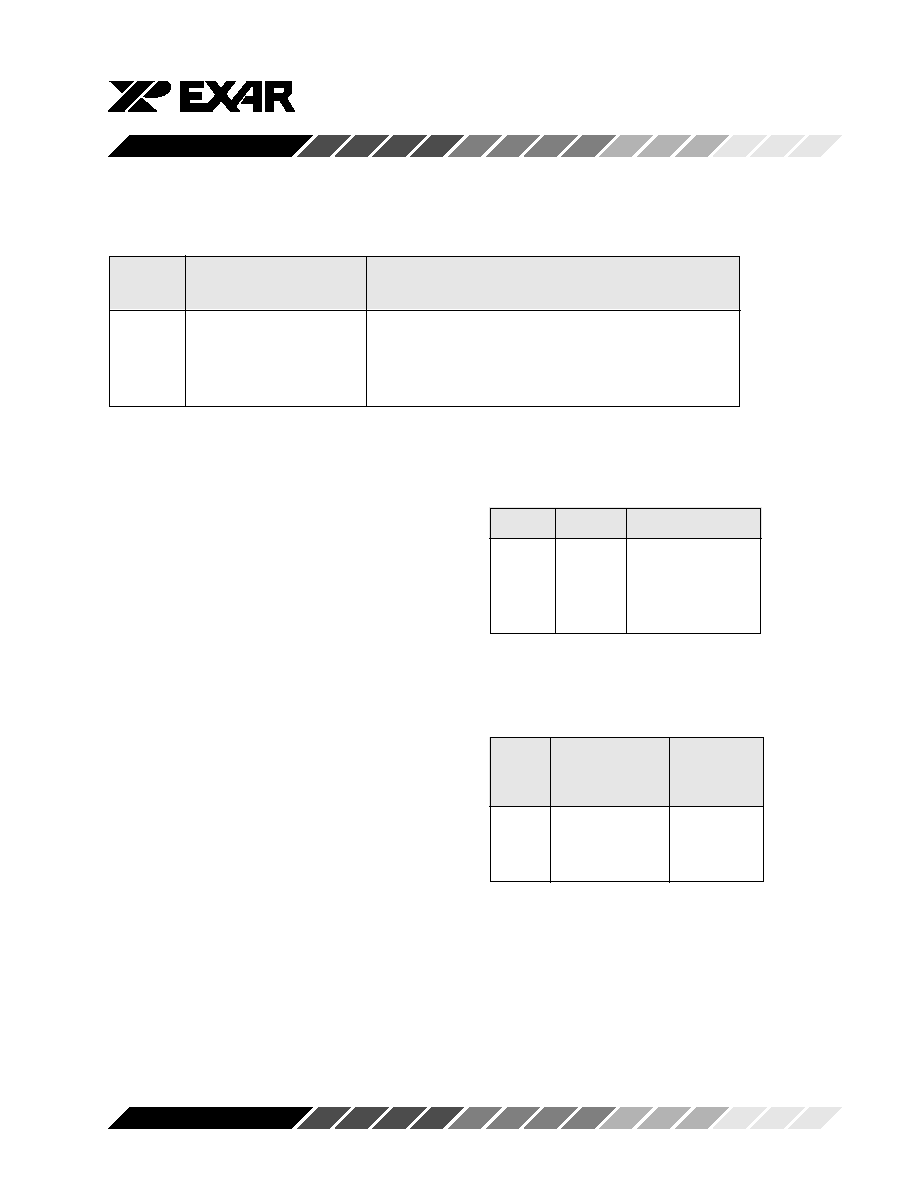
ST16C1450/51
15
Rev. 3.10
Table 6, INTERRUPT SOURCE TABLE
Priority
[ ISR BITS ]
Level
Bit-3 Bit-2 Bit-1 Bit-0
Source of the interrupt
1
0
1
1
0
LSR (Receiver Line Status Register)
2
0
1
0
0
RXRDY (Received Data Ready)
3
0
0
1
0
TXRDY (Transmitter Holding Register Empty)
4
0
0
0
0
MSR (Modem Status Register)
ISR BIT-0:
Logic 0 = An interrupt is pending and the ISR contents
may be used as a pointer to the appropriate interrupt
service routine.
Logic 1 = No interrupt pending. (normal default condi-
tion)
ISR BIT 1-3: (logic 0 or cleared is the default condition)
These bits indicate the source for a pending interrupt
at interrupt priority levels 1, 2, 3, and 4 (See Interrupt
Source Table).
ISR BIT 4-7: (logic 0 or cleared is the default condition)
Not Used - initialized to a logic 0.
Line Control Register (LCR)
The Line Control Register is used to specify the
asynchronous data communication format. The word
length, the number of stop bits, and the parity are
selected by writing the appropriate bits in this register.
LCR BIT 0-1: (logic 0 or cleared is the default condi-
tion)
These two bits specify the word length to be transmit-
ted or received.
BIT-1
BIT-0
Word length
0
0
5
0
1
6
1
0
7
1
1
8
LCR BIT-2: (logic 0 or cleared is the default condition)
The length of stop bit is specified by this bit in
conjunction with the programmed word length.
BIT-2
Word length
Stop bit
length
(Bit time(s))
0
5,6,7,8
1
1
5
1-1/2
1
6,7,8
2
LCR BIT-3:
Parity or no parity can be selected via this bit.
Logic 0 = No parity. (normal default condition)
Logic 1 = A parity bit is generated during the transmis-
sion, receiver checks the data and parity for transmis-
sion errors.
LCR BIT-4:
If the parity bit is enabled with LCR bit-3 set to a logic
1, LCR BIT-4 selects the even or odd parity format.

ST16C1450/51
16
Rev. 3.10
Logic 0 = ODD Parity is generated by forcing an odd
number of logic 1s in the transmitted data. The
receiver must be programmed to check the same
format. (normal default condition)
Logic 1 = EVEN Parity is generated by forcing an even
the number of logic 1s in the transmitted. The receiver
must be programmed to check the same format.
LCR BIT-5:
If the parity bit is enabled, LCR BIT-5 selects the
forced parity format.
LCR BIT-5 = logic 0, parity is not forced. (normal
default condition)
LCR BIT-5 = logic 1 and LCR BIT-4 = logic 0, parity bit
is forced to a logical 1 for the transmit and receive
data.
LCR BIT-5 = logic 1 and LCR BIT-4 = logic 1, parity bit
is forced to a logical 0 for the transmit and receive
data.
LCR
LCR
LCR
Parity selection
Bit-5
Bit-4
Bit-3
X
X
0
No parity
0
0
1
Odd parity
0
1
1
Even parity
1
0
1
Force parity 1
1
1
1
Forced parity 0
LCR BIT-6:
When enabled, the Break control bit causes a break
condition to be transmitted (the TX output is forced to
a logic 0 state). This condition exists until disabled by
setting LCR bit-6 to a logic 0.
Logic 0 = No TX break condition. (normal default
condition)
Logic 1 = Forces the transmitter output (TX) to a logic
0 for alerting the remote receiver to a line break
condition.
LCR BIT-7:
The internal baud rate counter latch and Enhance
Feature mode enable.
Logic 0 = Divisor latch disabled. (normal default
condition)
Logic 1 = Divisor latch and enhanced feature register
enabled.
Modem Control Register (MCR)
This register controls the interface with the modem or
a peripheral device.
MCR BIT-0:
Logic 0 = Force -DTR output to a logic 1. (normal
default condition)
Logic 1 = Force -DTR output to a logic 0.
MCR BIT-1:
Logic 0 = Force -RTS output to a logic 1. (normal
default condition)
Logic 1 = Force -RTS output to a logic 0.
MCR BIT-2:
In the normal mode, this bit is associated the RST
(buffered reset output) function and is enabled by bit-
5 of the IER register. The RST function is available on
28 pin ST16C1451 package only. The 48 pin
ST16C1450/51 package all provide the RST function.
While in the normal mode, the logical state of the RST
pin will follow exactly the logical state of RESET pin,
i.e., soft resets are disabled. During special mode
operation, soft resets from MCR bit 2 are ORd with
the state of the input pin, RESET. Therefore both reset
types will be seen at the RST pin.
Logic 0 = The RST output pin is a logic 0. (normal
default condition)
Logic 1 = The RST output pin is a logic 1
In the loop-back mode where MCR bit-4 is a logic 1 this
bit is used to write the state of the modem -RI interface
signal.
Loop-back mode, Logic 0 = sets -RI internally to a logic
1.
Loop-back mode, Logic 1 = sets -RI internally to a logic
0.
MCR BIT-3
This bit controls the tri-state interrupt function or in the
loop-back mode this bit is used to control the modem
-CD signal.
Logic 0 = Forces INT outputs to the tri-state mode or

ST16C1450/51
17
Rev. 3.10
sets -CD to a logic 1 in the loop-back mode. (normal
default condition).
Logic 1 = Forces the INT outputs to the active mode
or sets -CD to a logic 0 in the loop-back mode.
In the Loop-back mode, sets -CD internally to a logic
0.
MCR BIT-4:
Enable the local loop-back mode (diagnostics). In this
mode the transmitter output (-TX) and the receiver
input (-RX), -CTS, -DSR, -CD, and -RI are discon-
nected from the 145X I/O pins. Internally the modem
data and control pins are connected into a loop-back
data configuration. In this mode, the receiver and
transmitter interrupts remain fully operational. The
Modem Control Interrupts are also operational, but the
interrupts sources are switched to the lower four bits of
the Modem Control. Interrupts continue to be con-
trolled by the IER register.
Logic 0 = Disable loop-back mode. (normal default
condition)
Logic 1 = Enable local loop-back mode (diagnostics).
MCR BIT 5-6:
Not Used - initialized to a logic 0.
MCR BIT-7:
Logic 0 = No power down mode. (normal default
condition)
Logic 1 = Enable power down mode with baud rate
generator circuitry disabled.
Line Status Register (LSR)
This register provides the status of data transfers
between. the 145X and the CPU.
LSR BIT-0:
Logic 0 = No data in receive holding register. (normal
default condition)
Logic 1 = Data has been received and is saved in the
receive holding register (RHR).
LSR BIT-1:
Logic 0 = No overrun error. (normal default condition)
Logic 1 = Overrun error. A data overrun error occurred
in the receive shift register. This happens when addi-
tional data arrives while the RHR is full. In this case the
previous data in the shift register is overwritten. Note
that under this condition the data byte in the receive
shift register is not transferred into the RHR, therefore
the data in the RHR is not corrupted by the error.
LSR BIT-2:
Logic 0 = No parity error. (normal default condition)
Logic 1 = Parity error. The receive character does not
have correct parity information and is suspect.
LSR BIT-3:
Logic 0 = No framing error. (normal default condition)
Logic 1 = Framing error. The receive character did not
have a valid stop bit(s).
LSR BIT-4:
Logic 0 = No break condition. (normal default condi-
tion)
Logic 1 = The receiver received a break signal (RX
was a logic 0 for at least one character frame time).
LSR BIT-5:
This bit indicates that the 145X is ready to accept new
characters for transmission. This bit causes the 145X
to issue an interrupt to the CPU when the transmit
holding register is empty and the interrupt enable is
set.
Logic 0 = Transmit holding register (THR) is not
empty.
Logic 1 = Transmit holding register is empty. When
this bit is a logic 1, the CPU can load a maximum of
1 new characters into the Transmit Holding Register
for transmission. (normal default condition)
LSR BIT-6:
Logic 0 = Transmitter holding (THR) and shift registers
(TSR) are full.
Logic 1 = Transmitter holding and shift registers are
empty.
LSR BIT-7:
Not Used - initialized to a logic 0.
Modem Status Register (MSR)
This register provides the current state of the control
interface signals from the modem, or other peripheral
device that the 145X is connected to. Four bits of this

ST16C1450/51
18
Rev. 3.10
register are used to indicate the changed information.
These bits are set to a logic 1 whenever a control input
from the modem changes state. These bits are set to
a logic 0 whenever the CPU reads this register.
MSR BIT-0:
Logic 0 = No -CTS Change (normal default condition)
Logic 1 = The -CTS input to the 145X has changed
state since the last time it was read. A modem Status
Interrupt will be generated.
MSR BIT-1:
Logic 0 = No -DSR Change. (normal default condition)
Logic 1 = The -DSR input to the 145X has changed
state since the last time it was read. A modem Status
Interrupt will be generated.
MSR BIT-2:
Logic 0 = No -RI Change. (normal default condition)
Logic 1 = The -RI input to the 145X has changed from
a logic 0 to a logic 1. A modem Status Interrupt will be
generated.
MSR BIT-3:
Logic 0 = No -CD Change. (normal default condition)
Logic 1 = Indicates that the -CD input to the has
changed state since the last time it was read. A
modem Status Interrupt will be generated.
MSR BIT-4:
During normal operation, this bit is the compliment of
the -CTS input. During the loop-back mode this bit is
equivalent to MCR bit-1 (-RTS).
MSR BIT-5:
During normal operation, this bit is the compliment of
the -DSR input. During the loop-back mode, this bit is
equivalent to MCR bit-0 (-DTR).
MSR BIT-6:
During normal operation, this bit is the compliment of
the -RI input. Reading this bit in the loop-back mode
produces the state of MCR bit-2 for packages support-
ing the RST (soft reset) feature. The RST function is
associated with the 28 pin ST16C1451 and the 48 pin
ST16C1450/51 package only.
MSR BIT-7:
During normal operation, this bit is the compliment of
the -CD input. Reading this bit in the loop-back mode
produces the state of MCR bit-3 (INT - Interrupt).
Note: Whenever any MSR bit(s) 0-3: are set to logic
1, a MODEM Status Interrupt will be generated.
Scratchpad Register (SPR)
The ST16C145X provides a temporary data register to
store 8 bits of user information.
ST16C1450/51 EXTERNAL RESET CONDITIONS
REGISTERS
RESET STATE
IER
IER BITS 0-7=0
ISR
ISR BIT-0=1, ISR BITS 1-7=0
LCR
LCR BITS 0-7=0
MCR
MCR BITS 0-7=0
LSR
LSR BITS 0-4=0,
LSR BITS 5-6=1 LSR, BIT 7=0
MSR
MSR BITS 0-3=0,
MSR BITS 4-7=input signals
SIGNALS
RESET STATE
TX
High
SOFT reset
High
-RTS
High
-DTR
High
INT
Three state

ST16C1450/51
19
Rev. 3.10
AC ELECTRICAL CHARACTERISTICS
T
A
=0∞ - 70∞C (-40∞ - +85∞C for Industrial grade packages), Vcc=3.3 - 5.0 V ± 10% unless otherwise specified.
T
1w
,T
2w
Clock pulse duration
17
17
ns
T
3w
Oscillator/Clock frequency
8
24
MHz
T
4w
Address strobe width
35
25
ns
T
6s
Address setup time
5
0
ns
T
7d
-IOR delay from chip select
10
10
ns
T
7w
-IOR strobe width
35
25
ns
T
7h
Chip select hold time from -IOR
0
0
ns
T
9d
Read cycle delay
40
30
ns
T
12d
Delay from -IOR to data
35
25
ns
T
12h
Data disable time
25
15
ns
T
13d
-IOW delay from chip select
10
10
ns
T
13w
-IOW strobe width
40
25
ns
T
13h
Chip select hold time from -IOW
0
0
ns
T
15d
Write cycle delay
40
30
ns
T
16s
Data setup time
20
15
ns
T
16h
Data hold time
5
5
ns
T
17d
Delay from -IOW to output
50
40
ns
100 pF load
T
18d
Delay to set interrupt from MODEM
40
35
ns
100 pF load
input
T
19d
Delay to reset interrupt from -IOR
40
35
ns
100 pF load
T
20d
Delay from stop to set interrupt
1
1
Rclk
T
21d
Delay from -IOR to reset interrupt
45
40
ns
100 pF load
T
22d
Delay from stop to interrupt
45
40
ns
T
23d
Delay from initial INT reset to transmit
8
24
8
24
Rclk
start
T
24d
Delay from -IOW to reset interrupt
45
40
ns
T
R
Reset pulse width
40
40
ns
N
Baud rate devisor
1
2
16
-1
1
2
16
-1
Rclk
Symbol
Parameter
Limits
Limits
Units
Conditions
3.3
5.0
Min
Max
Min
Max
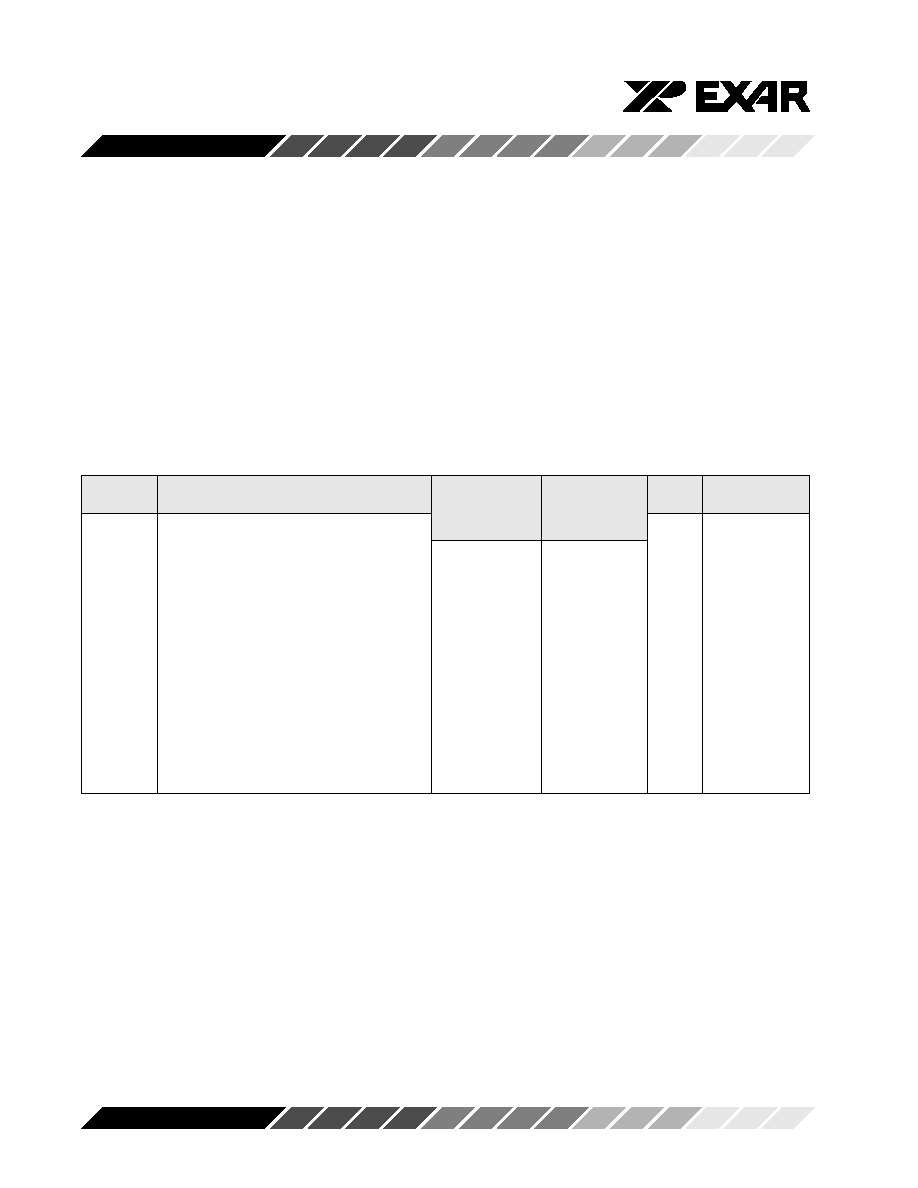
ST16C1450/51
20
Rev. 3.10
ABSOLUTE MAXIMUM RATINGS
Supply range
7 Volts
Voltage at any pin
GND - 0.3 V to VCC +0.3 V
Operating temperature
-40
∞
C to +85
∞
C
Storage temperature
-65
∞
C to 150
∞
C
Package dissipation
500 mW
DC ELECTRICAL CHARACTERISTICS
T
A
=0∞ - 70∞C (-40∞ - +85∞C for Industrial grade packages), Vcc=3.3 - 5.0 V ± 10% unless otherwise specified.
V
ILCK
Clock input low level
-0.3
0.6
-0.5
0.6
V
V
IHCK
Clock input high level
2.4
VCC
3.0
VCC
V
V
IL
Input low level
-0.3
0.8
-0.5
0.8
V
V
IH
Input high level
2.0
2.2
VCC
V
V
OL
Output low level on all outputs
0.4
V
I
OL
= 5 mA
V
OL
Output low level on all outputs
0.4
V
I
OL
= 4 mA
V
OH
Output high level
2.4
V
I
OH
= -5 mA
V
OH
Output high level
2.0
V
I
OH
= -1 mA
I
IL
Input leakage
±10
±10
µ
A
I
CL
Clock leakage
±10
±10
µ
A
I
CC
Avg power supply current
1.3
3
mA
C
P
Input capacitance
5
5
pF
Symbol
Parameter
Limits
Limits
Units
Conditions
3.3
5.0
Min
Max
Min
Max

ST16C1450/51
21
Rev. 3.10
General write timing
General read timing
A0-A2
-CS
-IOR
D0-D7
T6s
T7w
T7d
T7h
T9d
T12d
T12h
X552-RD-1
Active
Data
Valid
Address
Active
A0-A2
-CS
-IOW
D0-D7
T6s
T13w
T13d
T13h
T15d
T16s
T16h
X552-WD-1
Valid
Address
Active
Active
Data

ST16C1450/51
22
Rev. 3.10
External clock timing
Modem input/output timing
-IOW
-RTS
-DTR
-CD
-CTS
-DSR
INT
-IOR
-RI
T17d
T18d
T18d
T19d
T18d
X552-MD-1
Active
Active
Change of state
Change of state
Active
Active
Active
Change of state
Change of state
Change of state
Active
Active
T3w
T1w
T2w
EXTERNAL
CLOCK
X654-CK-1

ST16C1450/51
23
Rev. 3.10
Receive timing
STOP
BIT
PARITY
BIT
DATA BITS (5-8)
D0
D1
D2
D3
D4
D5
D6
D7
5 DATA BITS
6 DATA BITS
7 DATA BITS
START
BIT
RX
NEXT
DATA
START
BIT
INT
-IOR
T20d
T21d
16 BAUD RATE CLOCK
X552-RX-1
Active
Active

ST16C1450/51
24
Rev. 3.10
Transmit timing
STOP
BIT
PARITY
BIT
DATA BITS (5-8)
D0
D1
D2
D3
D4
D5
D6
D7
5 DATA BITS
6 DATA BITS
7 DATA BITS
START
BIT
TX
NEXT
DATA
START
BIT
INT
T22d
T24d
16 BAUD RATE CLOCK
X552-TX-1
-IOW
T23d
Active
Active
Tx Ready
Active
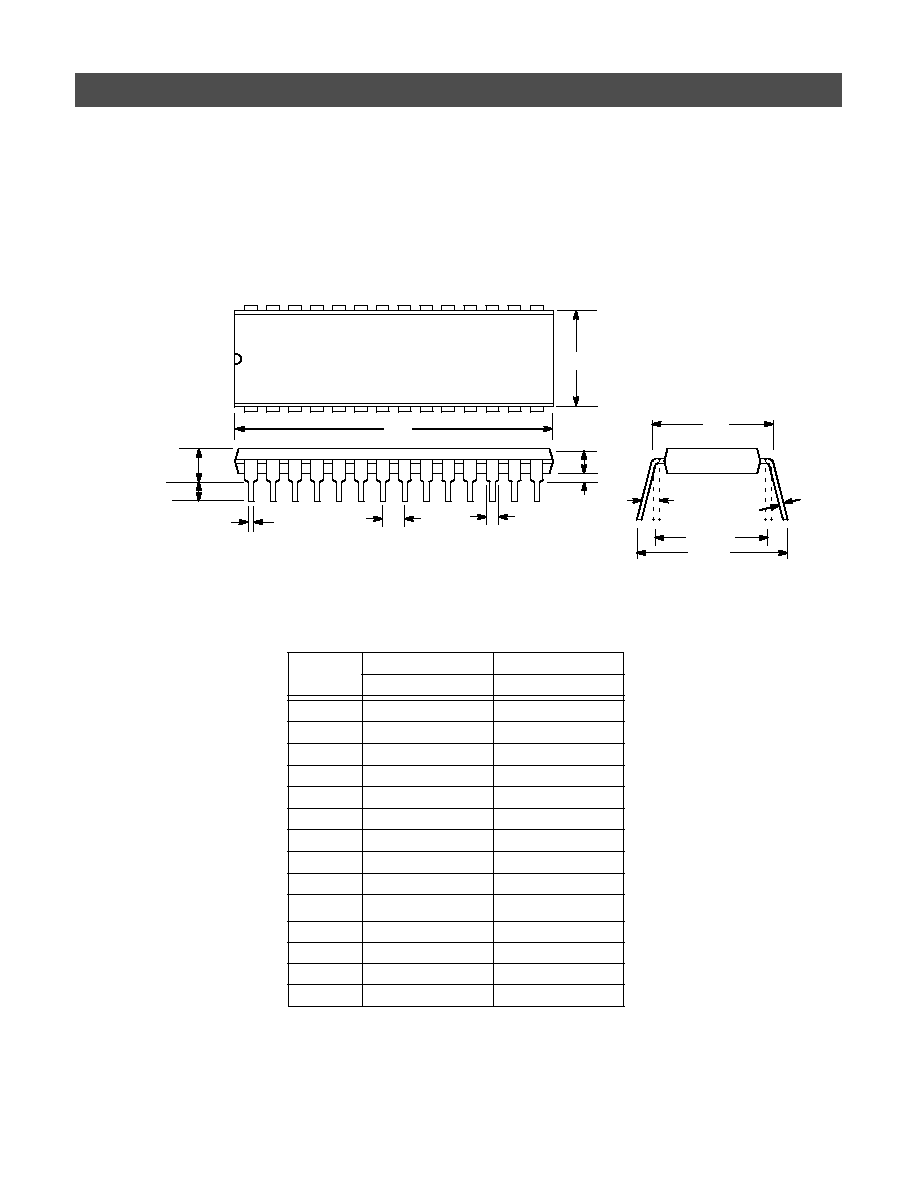
Package Dimensions
28 LEAD PLASTIC DUAL-IN-LINE
(600 MIL PDIP)
Rev. 1.00
SYMBOL
MIN
MAX
MIN
MAX
INCHES
A
0.160
0.250
4.06
6.35
A
1
0.015
0.070
0.38
1.78
A
2
0.125
0.195
3.18
4.95
B
0.014
0.024
0.36
0.56
B
1
0.030
0.070
0.76
1.78
C
0.008
0.014
0.20
0.38
D
1.380
1.565
35.05
39.75
E
0.600
0.625
15.24
15.88
E
1
0.485
0.580
12.32
14.73
e
0.100 BSC
2.54 BSC
e
A
0.600 BSC
15.24 BSC
e
B
0.600
0.700
15.24
17.78
L
0.115
0.200
2.92
5.08
0
∞
15
∞
0
∞
15
∞
MILLIMETERS
28
1
15
14
D
B
1
A
1
E
1
E
A
L
B
Seating
Plane
e
C
A
2
Note: The control dimension is the inch column
e
B
e
A

Package Dimensions
28 LEAD PLASTIC LEADED CHIP CARRIER
(PLCC)
Rev. 1.00
1
D
D 1
D
2
A
A
1
D
D
1
D
3
A
0.165
0.180
4.19
4.57
A
1
0.090
0.120
2.29
3.05
A
2
0.020
≠≠≠.
0.51
≠≠≠
B
0.013
0.021
0.33
0.53
B
1
0.026
0.032
0.66
0.81
C
0.008
0.013
0.19
0.32
D
0.485
0.495
12.32
12.57
D
1
0.450
0.456
11.43
11.58
D
2
0.390
0.430
9.91
10.92
D
3
0.300 typ.
7.62 typ.
e
0.050 BSC
1.27 BSC
H1
0.042
0.056
1.07
1.42
H2
0.042
0.048
1.07
1.22
R
0.025
0.045
0.64
1.14
SYMBOL
MIN
MAX
MIN
MAX
INCHES
MILLIMETERS
B
A
2
B
1
e
Seating Plane
2
28
Note: The control dimension is the inch column
D
3
45
∞
x H2
45
∞
x H1
C
R
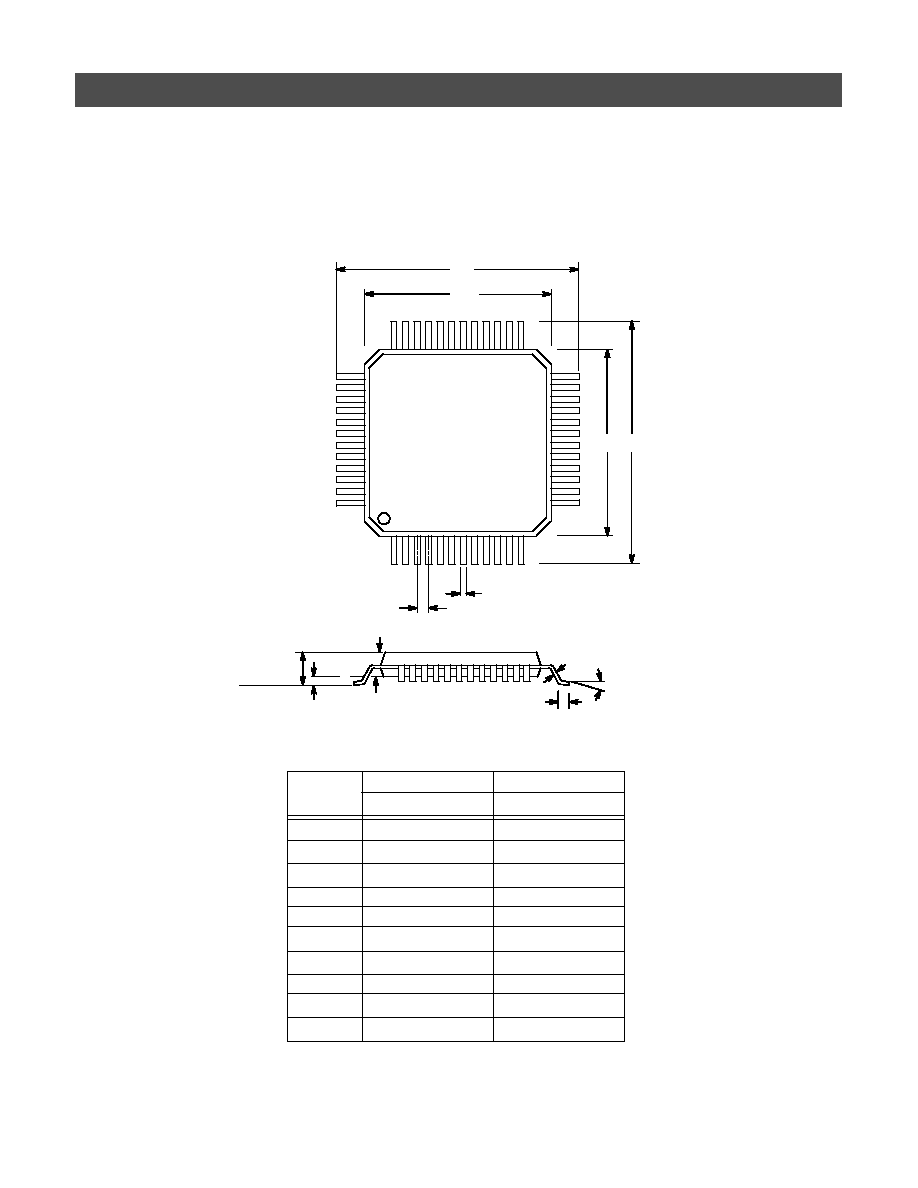
Package Dimensions
48 LEAD THIN QUAD FLAT PACK
(7 x 7 x 1.0 mm, TQFP)
Rev. 1.00
36
25
24
13
1
12
37
48
D
D
1
D
D
1
B
e
A
2
A
1
A
Seating Plane
A
0.039
0.047
1.00
1.20
A
1
0.002
0.006
0.05
0.15
A
2
0.037
0.041
0.95
1.05
B
0.007
0.011
0.17
0.27
C
0.004
0.008
0.09
0.20
D
0.346
0.362
8.80
9.20
D
1
0.272
0.280
6.90
7.10
e
0.020 BSC
0.50 BSC
L
0.018
0.030
0.45
0.75
0
∞
7
∞
0
∞
7
∞
SYMBOL
MIN
MAX
MIN
MAX
INCHES
MILLIMETERS
Note: The control dimension is the millimeter column
L
C

NOTICE
EXAR Corporation reserves the right to make changes to the products contained in this publication in order to im-
prove design, performance or reliability. EXAR Corporation assumes no responsibility for the use of any circuits de-
scribed herein, conveys no license under any patent or other right, and makes no representation that the circuits are
free of patent infringement. Charts and schedules contained here in are only for illustration purposes and may vary
depending upon a user's specific application. While the information in this publication has been carefully checked;
no responsibility, however, is assumed for inaccuracies.
EXAR Corporation does not recommend the use of any of its products in life support applications where the failure or
malfunction of the product can reasonably be expected to cause failure of the life support system or to significantly
affect its safety or effectiveness. Products are not authorized for use in such applications unless EXAR Corporation
receives, in writing, assurances to its satisfaction that: (a) the risk of injury or damage has been minimized; (b) the
user assumes all such risks; (c) potential liability of EXAR Corporation is adequately protected under the circum-
stances.
Copyright 1991 EXAR Corporation
Reproduction, in part or whole, without the prior written consent of EXAR Corporation is prohibited.



























